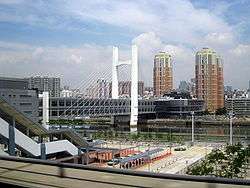Futian Port




Futian Port (Chinese: 福田口岸) is an immigration port of entry on the border between mainland China and Hong Kong, located in the Futian District of Shenzhen in mainland China. It is in the same building as Shenzhen Metro's Futian Checkpoint Station and acts as the Hong Kong counterpart to the Lok Ma Chau Spur Line Control Point.
It is connected with Hong Kong's Lok Ma Chau Spur Line Control Point and MTR's Lok Ma Chau Station in Lok Ma Chau, Hong Kong through a pedestrian footbridge.[1] It has been in operation since 15 August 2007 and is the second border crossing along the border with a railway connection, after Luohu Port/Lo Wu Control Point.[2]
Pedestrian bridge
The Shenzhen subway at Futian Port is connected to the East Railway Station in Lok Ma Chau, Hong Kong by Futian-Lok Ma Chau Pedestrian Bridge. This is a double-deck bridge with a cable-stayed on the top, which is novel and unique worldwide. Its length is 211 metres (692 ft), the depth of the deeper side is 87 metres (285 ft), and the width is 16.5 metres (54 ft). The upper and the lower layers are both unidirectional, to ensure that passengers do not meet those crossing in the opposite direction. Also, there is an immigration control point at both sides of the bridge. There are separate passages for the blind on the bridge. On the east of the bridge is the united checking building and on its west is the united checking building of Lok Ma Chau, Hong Kong. Because of the subway and the united checking building, and the subway and the ground transportation together carrying the passengers entering and exiting, it will become a three-dimensional transportation thoroughfare between underground and ground. Squares, lawns and roads will be built around the stations and united checking building, according to regional planning. Once completed, the daily passenger capacity will be 190,000. Passengers from Hong Kong and Macau will spend only 15 seconds entering.[3]
See also
References
- ↑ "Journey to Hong Kong". annatam.com. May 25, 2008.
- ↑ "Archives - Press Releases - Transport - Land and Waterborne Transport". Transport and Housing Bureau Hong Kong. August 15, 2007.
- ↑ "Immigration Formalities Guide for Travelers". Shenzhen: Shenzhen General Station of Immigration Inspection. Retrieved 4 April 2013.
Coordinates: 22°30′57″N 114°04′08″E / 22.51577°N 114.06877°E